Cannabis infused coconut oil is perhaps the safest, cleanest and most effective type of medical marijuana oil available. Coconut cannabis oil is easy and inexpensive to make and requires no special equipment, which means that anyone can produce their own high-quality therapeutic oil. This article contains all of the information you need to make your own extremely potent cannabis infused coconut oil.
Cannabis Infused Coconut Oil: Why it’s the Best Cannabis Oil Method
Most methods of cannabis oil production call for the use of dangerous solvents like naptha, isopropyl or benzene, or pressurized gasses like butane. For instance, “RSO oil” or “Rick Simpson Oil” (also called Phoenix Tears) is produced using isopropyl. BHO, on the other hand, is an acronym for “Butane Hash Oil,” which obviously uses butane as a chemical solvent.
Solvents and gasses are generally acceptable in a highly regulated medical laboratory, but in many cases today’s cannabis oil is not produced in such an environment. Consequently solvent residues often appear in finished therapeutic oil products, posing a potential danger to people who consume the substance. This is especially true of cancer patients, who are often advised to stay away from alcohol.
Solvent residue is not only a health concern, it also significantly affects the taste, appearance, smell and effects of the finished oil products.
Solvents are highly toxic; gases produced when boiling off a solvent are extraordinarily dangerous to inhale and can be difficult to control. Additionally, these gases are explosive and oil production methods that use solvents can (and sometimes do) result in catastrophic explosions.
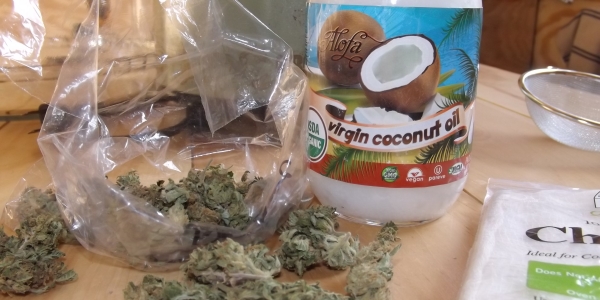
Coconut oil, on the other hand, is food. It’s not a solvent, it’s not a gas and it poses no danger to anyone when processed or consumed. There are no chemical precursors or byproducts in coconut oil. In fact, when organic virgin coconut oil is used in combination with organic marijuana, a truly safe and organic cannabis oil can be produced. This is not possible with solvents.
Cannabis infused coconut oil can be made by anyone, including people with little to no experience in the cannabis industry. Conversely, the production of solvent-based oils should be reserved to professionals who work in a secure environment.
Finally, coconut oil has significant health benefits independent of marijuana. This article is not about that so please conduct your own research if you don’t already understand the significant value of coconut oil as a food item. If you are from an older generation, I especially encourage you to research coconut oil as it was at one time demonized in the United States and some other affluent countries as a dangerous type of saturated fat.
INSTRUCTIONS FOR MAKING COCONUT CANNABIS OIL
Please read these instructions in their entirety prior to collecting equipment and supplies. Don’t try to read through this as you go along and make the oil. Read this entire document first, examine all of the photographs, and then collect the equipment and begin the process. The process will be much easier if you understand how everything will be used in this project.
EQUIPMENT NEEDED:

*High quality cannabis (Organic whole dried flower is recommended for medical purposes. Trim, shake, other materials should be reserved for different types of cannabis products. Strains that are 1:1 THC/CBD ratio are the current industry-accepted standard. In lieu of this, a strong indica strain is best.)
*Crock Pot (Possible alternative: traditional pot on low heat, watched VERY carefully)
Use: Crock pots have a “warm” or low setting that makes it virtually impossible to burn what you are cooking. Additionally, a crock pot is designed to heat for many hours at a time, which is important for cannabis oil recipes.
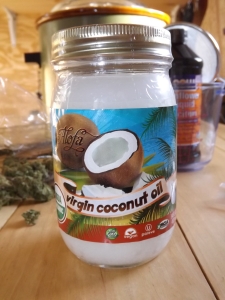
*Coconut Oil (Recommended alternative: Honey, but requires slightly different process)
Use: In this method coconut oil is the solvent or binding agent; the fatty lipids and oils bind to the psychoactive ingredients in cannabis and allow for rapid absorption/nutritional uptake
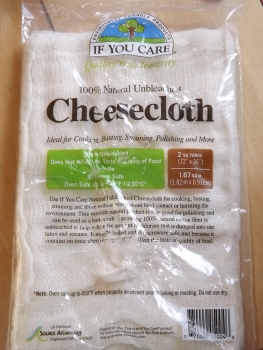
*Cheesecloth (Possible alternative: Coffee filters, tea filters, empty tea bags)
Use: Cheesecloth will be used to cleanly and safely press the oil from the finished, rendered substance.
*Twist ties (Possible alternative: rubber bands, twine, string, etc.)
Use: To tightly cover or secure the cheesecloth to the jar and/or strainer
*Glass jars with lids, canning type is preferred (Possible alternatives: any glass container, plastic syringes, stone jars)
Use: Storage of finished oil
*Small strainer
Use: Safely catches and strains anything that falls out of the cheesecloth, including fabric fibers
*Glass baking dish (Possible alternative: standard baking dishes or sheets)
Use: Cannabis must be placed in baking dish and baked in order to achieve decarboxylation. This is the chemical process that “activates” the psychoactive components of marijuana. The coconut oil and slow cooking process then acts as a binding agent. [Remember; THC/CBD are fat-soluble chemicals]
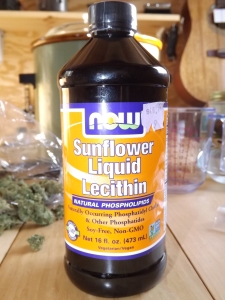
*Sunflower Lecithin (Possible alternative; Soy Lecithin, or can be omitted from recipe entirely)
Use: Additional binding agent
MAKING THE CANNABIS INFUSED COCONUT OIL:
This is a 1:1 recipe, which means that you can adjust it according to the equipment and kitchen, etc. The general guideline is that for every cup of cannabis, you will need approximately one cup of coconut oil. You can increase the recipe as long as you maintain the 1:1 ratio.
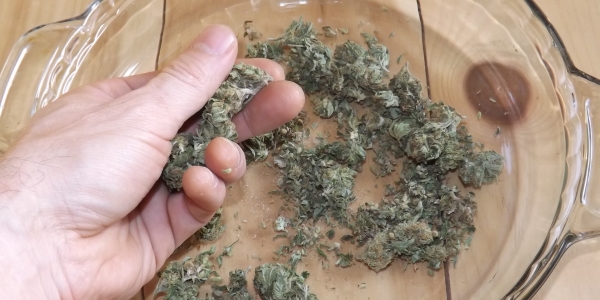
1. Break up the buds by hand. Ensure the buds are well broken up, but don’t grind them into dust.
2. Preheat oven to 240 F / 115 C
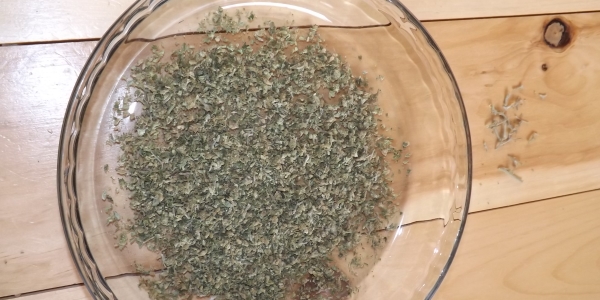
3. Spread the buds evenly onto the baking dish
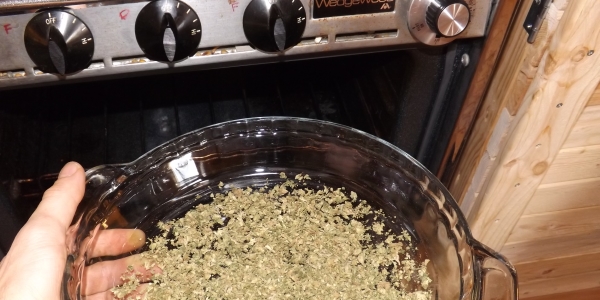
4. Bake for one hour
5. Remove cannabis from oven
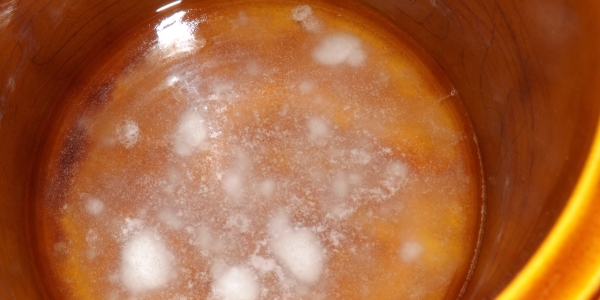
6. Melt coconut oil in crock pot until it becomes liquid
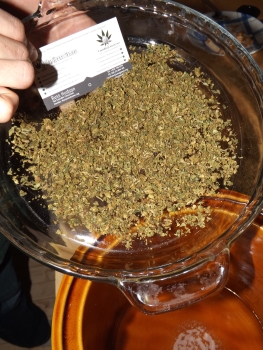
7. Add cannabis and sunflower lecithin to crock pot (ensure that the oil in the pot completely covers the cannabis) Use approximately one tablespoon of lecithin per cup of coconut oil.
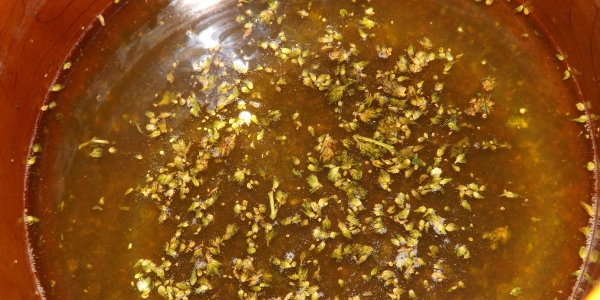
8. Heat mixture in crock pot on warm or low setting for 2 ½ hours, carefully and slowly stirring every 10-15 minutes. Do not allow the oil to smoke – if smoking occurs, the temperature is too hot and oil is being lost.
9. Turn off crock pot
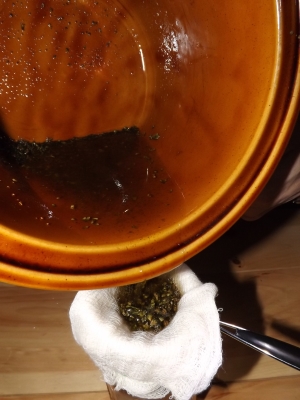
10. Place cheesecloth in strainer and place strainer over top of glass storage jar
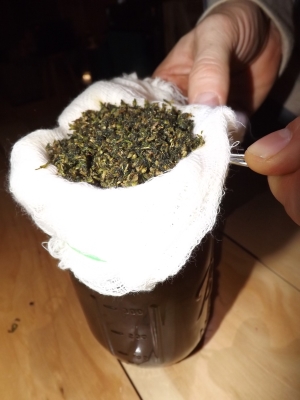
11. Slowly pour the mixture of oil and cannabis into the cheesecloth and strainer
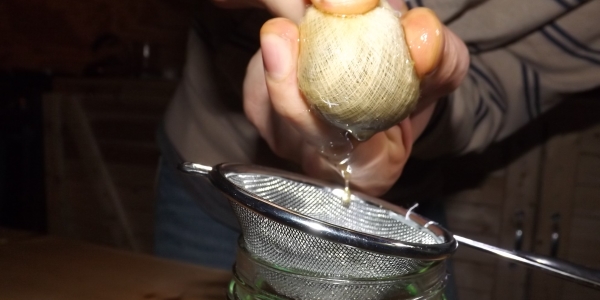
12. Gather the ends of the cheesecloth and secure with twist ties, rubber bands, string, your fingers, etc.
13. Squeeze and/or wring the plant matter in the cheesecloth and allow the oil to flow into the jar Squeeze hard but don’t break the cheesecloth.
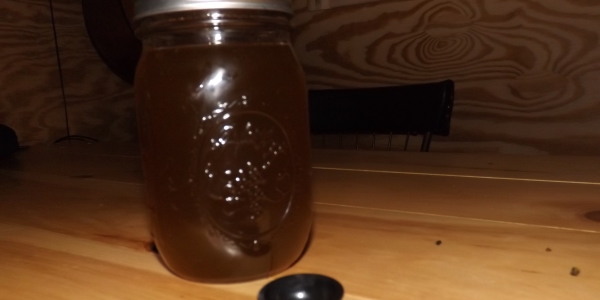
14. Place lid tightly on jar and store in refrigerator if possible, otherwise in a cool, dry and dark place
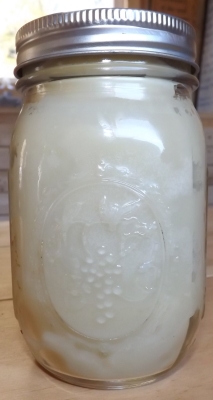
DOSAGE:
Initial dosing for inexperienced users is approximately ½ teaspoon, increasing with continued treatment or therapy, up to 1 tablespoon or more, depending on condition treated.
Experienced users may start with a full or rounded teaspoon and increase dosage as needed.
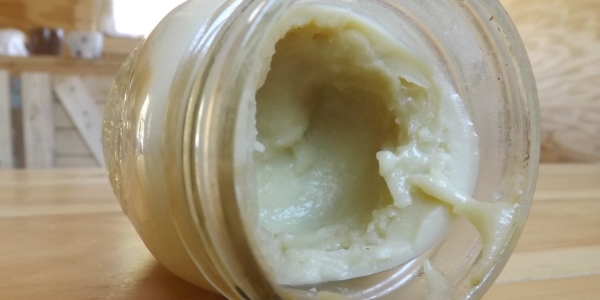
CONSUMPTION:
Cannabis infused coconut oil can be eaten directly, applied to skin, or it can be eaten with food in a variety of different ways. Coconut cannabis oil can also be put in capsules and taken orally or rectally.
When not in use always store cannabis infused coconut oil in the refrigerator or a cool, dry and dark place.
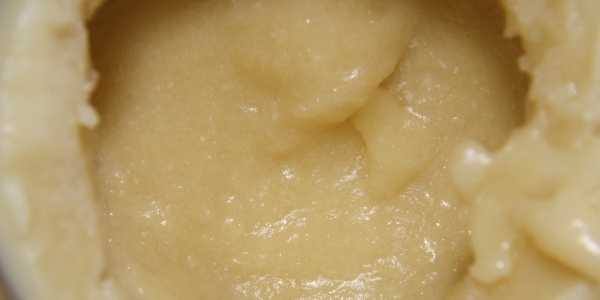
Simple Disclaimer: I’m not a doctor or health care professional. This article is not to be considered professional medical advice. Cannabis oil is very strong. If you take too much, you will have a negative experience.
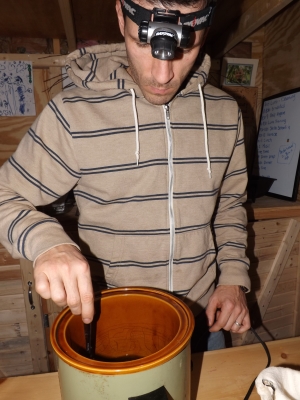
- Barcelona Cannabis Club Review: Green Age - March 23, 2022
- Things to do after Smoking Weed in Barcelona - March 2, 2022
- 9 Things You Need to Know about Cannabis Clubs in Madrid - February 15, 2022


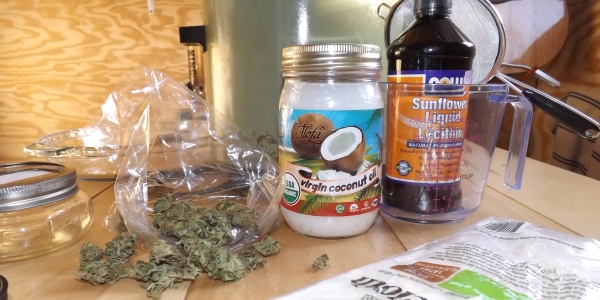
38 thoughts on “How to Make Cannabis Infused Coconut Oil”
Hi, do you make it with honey in the slow cooket the same way,? I cup of cannibis, 1 cup of honey, same with coconut 1 cup to 1 cup? 2.5 hours cooking
Hi Russ. I have been driving hours every month to get rso for my dad who has a rare cancer. When he was diagnosed and given 1 year to live I started him on rso and the cancer is gone! I would love to make this for him but wondering if it will have the same effect on cancer as rso does?
Hi Russ I was wondering if I could use this for a potent smelling candle? I want the smell to be as strong as it is when you light it up
How long can you store kief while you are collecting it?
As long as it’s stored properly, you can keep it indefinitely. You can long cure / age kief and iceolator just like you can flowers. 😉
Any feedback or reviews you can share about this recipe? Thank you!
Haven’t received any sorry, just questions about the process, but so far no one has reported back to me with their results.
When baking the flower in the oven and cooking it all in the crockpot how potent is the odor?
Hola Nate; the smell coming from the oven and crockpot will be pretty strong, but most people won’t recognize it as a “weed” smell, as it’s fairly different than cannabis that is actually burning. The smell will remain in your house or apartment for several hours after making the product. In any case, use caution if you have nosy neighbors. Peace -Russ
I made my canna coconut oil in the crockpot last night. First time trying something like this and I made a couple mistakes. I used more flower than recommended — 43 grams — and of course, the 16 ounces of coconut oil didn’t cover all the flower. So, I may have left some product on the table.
I made some coconut oil peanut butter cookies after that to sample my handiwork. Very nicely done. The effect is not a traditional high, more of a total body calming experience, and seems to behave like a general anti-anxiety and anti-inflammatory. Slept like a baby.
Sounds yummy, nice work!
Hello Russ. I was reading a prior comment from you and another person, and had a quick question on your comment – how do I double and triple infuse? I am planning to make this and use in place of RSO for my breast cancer, so I need this coconut oil-cannabis mixture to be as or more potent than RSO. Please advise as soon as you are able. Thank you!!!
Is the potency the same a rso made with alcohol, I have disease/illnesses where I cant have alcohol and afraid I can get it all out of the rso but need to have the most potent product that i can produce so is the coconut cannibis oil as strong and potent as rso with alcohol/ethanol.
Also do you have to use the sunflower lectithin?
Hope to hear back Asap needing to make this week. Thank you!!!!
Hola Ashlyn; it really depends on how you make it; you can double- and even triple-infuse the coconut oil, so yes; you can make this type of oil as potent as RSO, and in some cases, even more potent. You really should use the lecithin, I don’t think it will work as well without it. Best wishes Peace -Russ
I just had a question about making cooking oil from RSO type oil. It’s very concentrated so I’m not sure how much RSO oil to add to my coconut oil. Is there a special process?
Thanks
Hola Stephanie; without knowing how concentrated it is, it’s impossible to say how much you should use. It sounds like you’ll need to experiment with it a little bit, let us know how it goes!
Is there a shelf life for this oil? Will the quality be affected by reheating again and again?
Hola Rom; I’m not sure about the exact shelf life, but it’s got to be at least a few months or more if stored properly. I don’t recommend heating and reheating it; only heat the portion you use. If you do need to reheat the entire jar or batch, then make sure to do it slowly and at low temperature, ideally with a candle warmer or something else fairly benign. Best wishes Peace -Russ
My 27 year-old daughter has been diagnosed with anaplastic astrocytoma
(brain cancer). She was diagnosed almost 3 years ago and has undergone surgery, radiation and oral chemo. What would be the recommended type of cannabis oil for brain cancer?
Hola Mitch; I’m really not sure how helpful cannabis oil will be in treating a brain tumor, but it can certainly help with neuropathy, nausea, exhaustion, depression, etc., associated with traditional treatment methods. Personally I think oil made with coconut oil or honey is the best, but straight medical grade oil produced in a laboratory could be the most beneficial. We don’t know; we just don’t have the science yet. Best wishes for you and yours. Peace -Russ
my mitch my name joshi and I m research scientist working actively with cannabis for dermal and oral administration for various disorder and I recommend following recipe
1 spoon of cannabis with THC and CBD in ratio of 1; 1 with coconut oil
2. Spoon of Hyaluronic acid serum and
3. Spoon of avocado pure oil mix all together and store in amber color bottle and shake bottle before use and apply 2-5 ml of head and massage thoroughly every day in night and she may feel some drowsiness and excess sleep but it is ok and try after 1 month and show doctor her progress
Hi Russ, thanks for the info. I have another question, after I heat the infused coconut oil to insert into the capsule will it melt the capsule? Have you tried this and ifso, how do you do it.
Hi Jim; you won’t be heating the coconut oil enough to melt the capsule; you just need it enough to pour, which isn’t much above room temperature. Capsules are meant to dissolve with water and heat at about 98 degrees, so you should be all set to just warm the oil for pouring. Let me know how it goes! Peace -Russ
Do you need to fill gel capsules from the melted infused coconut oil, or can you reheat the infused coconut oil and fill the capsules then.
Hi Jim; I think it’s best to let the oil solidify, then re-heat and place in the capsules. Best wishes Peace -Russ
What, if anything, can you do with the leftovers in the cheesecloth?
I’m not sure there is much you can do with it; normally I’d say give it as animal feed, but the mash is probably psychoactive…
I use the leftovers to make cookies, just mix 1 cup of it in at the end and bake. One cookie a night and I sleep very well, which is something I’ve never been very good at at… Any excess I keep in the freezer for baking with later.
Cool, sounds yummy. What do you use for a sweetener, if any?
Can u use this oil in a vaporizer pen?
I really don’t know if you technically can do this or not, but I wouldn’t recommend it. Eat it or use it in capsules; that’s the best way. Peace -Russ
Thanks for the recipe
Thanks Tami, let me know how it goes for you! Peace -Russ
Awesome job Russ thanks for the share. Headed to the grocery now 🙂
Cool, please let us know how it goes! You can send an update here and I will post it, or you can even send some photos if you want. russ@marijuanagames.org. Thanks Eric! Peace -Russ
I’m interested in tinctures & such for sore joints and just multi use tinctures for health. If you cook with this oil, you get the high sensation correct? If you use as s rub on your skin, what is the benefit and do you get high?
Thanks! Very inknowledgable about this stuff!
Hola Micah! Yes, if you cook with this, you will get high and/or “medicated.” 😉
Yes, you can rub the cannabis infused coconut oil directly on skin ailments. You’ll probably not use enough to get high, unless you are a real lightweight and/or have liver problems. I will be doing a case study using this oil and will test various items including whether the oil when rubbed on skin and left on will cause a high or not. I will publish that article here and on Facebook so make sure to subscribe to one of those feeds to get updated on it instantly. On a side note, most tinctures are just raw oil that has been diluted in alcohol. Try making the coconut oil and see how you like it for joints and muscles; it might not be as physically clean as a tincture, but it’s probably a lot more effective and healthier.
Thanks for stopping by Micah! Peace -Russ